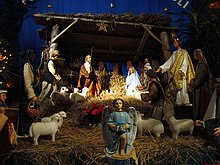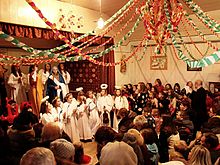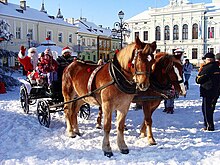Christmas in Poland
| Christmas in Poland | |
|---|---|
Christmas Day dinner serving of bigos on December 25 | |
 Christmas markets are held in every major city, especially in Kraków (pictured) | |
 Nativity scene at the Catholic Church of Christ the King in Sanok | |
 Nativity play (Jasełka or Herody) by children | |
 with Saint Nicholas with Saint Nicholas |
Christmas in Poland is a major annual celebration, as in most countries of the
The
Other aspects of Polish Christmas include nativity plays called "Jasełka" or "Herody", outdoor
Advent

Among the special tasks carried out in private homes during
Traditionally, the Christmas trees are decorated with glass
During Advent and all the way until
Wigilia, the Christmas Eve supper
In Poland,
On the night of Christmas Eve, so important is the appearance of the first star in remembrance of the Star of Bethlehem, that it has been given an affectionate name of "the little star" or Gwiazdka (the female counterpart of St. Nicholas). On that evening, children watch the sky anxiously hoping to be the first to cry out, "The star has come!" Only after it appears, the family members sit down to a dinner table.[2]
According to tradition, bits of hay are spread beneath the tablecloth as a reminder that Christ was born in a
The supper begins with the breaking of the opłatek wafer. Everyone at the table breaks off a piece and eats it as a symbol of their unity with Christ. They then share a piece with each family member. A tradition exists among some families to serve twelve different dishes at Wigilia symbolizing the
A traditional Wigilia supper in Poland includes fried
The remainder of the evening is given to stories and songs around the Christmas tree. In some areas of the country, children are taught that "The Little Star" brings gifts. As presents are unwrapped, carollers may walk from house to house receiving treats along the way.
Christmas Eve ends with "Pasterka", the Midnight Mass at the local church. The tradition commemorates the arrival of the shepherds to Bethlehem and their paying of respect and bearing witness to the newborn Messiah. The custom of Christmas night liturgy was introduced in the Christian churches after the second half of the 5th century. In Poland that custom arrived together with the coming of Christianity.[2] The next day (December 25) begins with the early morning mass followed by daytime masses. According to scripture, the Christmas Day masses are interchangeable allowing for greater flexibility in choosing the religious services by individual parishioners.[7]
Kolędy, the Christmas carols
Polish hand-made Christmas ornaments

Poland produces some of the finest hand blown glass Christmas ornaments in Europe. Families and collectors value these ornaments for high quality, traditional artwork, and unique decorations.[10]
Polish blown-glass Christmas ornaments are generally manufactured only in the winter season. The modern glass workshops and manufacturers tend to be localized in the southern regions of Poland.[10][11]
See also
- Easter in Poland
- God Is Born
- Kraków szopka
- Wigilia the Christmas Eve vigil supper
- Christmas worldwide
References
- ^ a b "UNESCO - Nativity scene (szopka) tradition in Krakow". ich.unesco.org. Retrieved 30 November 2018.
- ^ a b c d e f g "Boże Narodzenie i polskie tradycje," Polska Misja Katolicka, Amsterdam (in Polish)
- ^ "Christmas - Tłumacz - Onet.pl Portal wiedzy". Archived from the original on 2016-03-04. Retrieved 2013-09-12.
- ^ "How Poles Celebrate Christmas (Recipes Included)". Archived from the original on 18 January 2020. Retrieved 15 December 2017.
- ^ a b "Traditional Christmas Eve in Poland- Wigilia w Polsce- tradycje". 7 December 2015. Retrieved 15 December 2017.
- ^ "The tradition of decorating the Christmas tree - Our Ancestors". 2022-12-13. Archived from the original on 2022-12-17. Retrieved 2022-12-17.
- ^ "Pasterka przed północą... (Pasterka before midnight)". Przewodnik Katolicki 02/2009 (Catholic Guide). Drukarnia i Księgarnia św. Wojciecha. Archived from the original on 2013-04-16.
- ^ "The Shepherds' Mass". Polish-American Liturgical Center.org. 2008. Retrieved December 21, 2012.
- ^ Lorraine Grochowsa Kiefer, Christmas Kolędy - Polish Carols Archived 2011-03-17 at the Wayback Machine, at culture.polishsite.us
- ^ a b LUXORNA, Polskie ręcznie wytwarzane i zdobione bombki choinkowe, katalog. Retrieved December 29, 2014.
- ^ Lista produktów kategorii Ozdoby Formowane. Bilinski. Retrieved December 29, 2014.
External links
- Polish Christmas Eve Traditions
- Poland Christmas Traditions Archived 2013-03-28 at the Wayback Machine
- Christmas in Poland
- How to celebrate Christmas in Poland[permanent dead link]
- Boże Narodzenie, www.pmkamsterdam.nl (Polska Misja Katolicka, Amsterdam)
- Wigilia article from the Polish American Center
- Wigilia article from Pope John Paul II Polish Center
- Wigilia article from the Polish Museum of America[permanent dead link]
